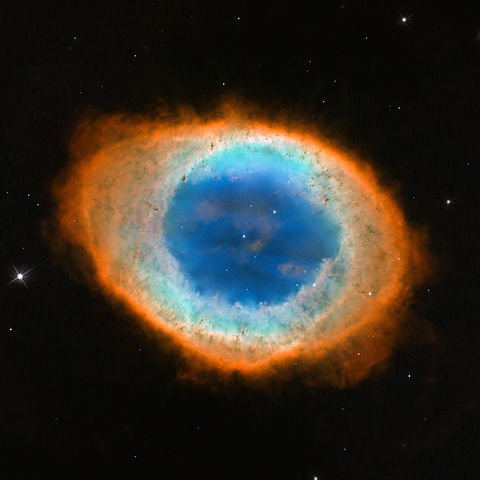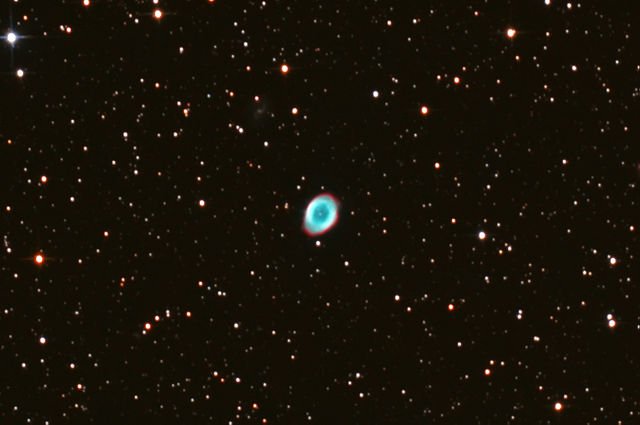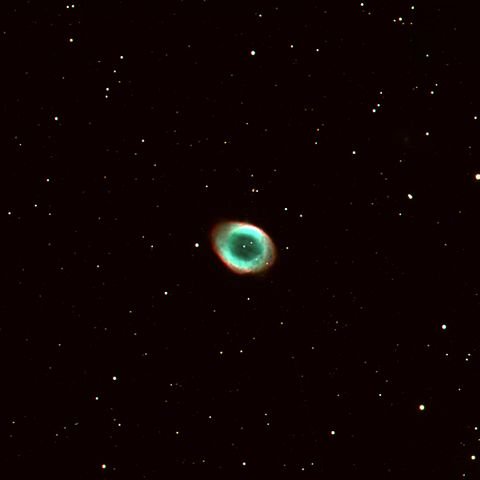Astronomical observations #15 : Ring Nebula (M57)
M57 is the second planetary nebula discovered after the Dumbbell Nebula (M27) that I've described to you lately. Above is a beautiful picture of the Ring Nebula that comes from the Hubble space telescope. We can't see such colorful views, unfortunately, but it is an object that can be seen even by smaller telescopes. M57 is located between the beta and gamma stars of the Lyra constellation. To find the object you need a telescope with a minimum diameter of 4" (100 mm). Binoculars can be hard. This nebula is tiny and in the sky it occupies only 1 arc minute, i.e. it corresponds to the size of the planet Jupiter. Its brightness is +9 mag, meaning it isn't visible to the naked eye (the range of the human eye is about +6 mag). Despite the low brightness, this object is small, which is why it is a fairly surface-bright nebula. Instrument with a diameter of 6'' and good conditions will allow you to see a blue-green ring with a darker center.
The M57 view using this medium telescope is shown next to it. Of course, in amateur telescopes, colors are only visible on planets. The Ring Nebula has well-defined edges and small size, so it can be viewed even at high magnification. The oval is clear and its center is filled with a fine mist. When we watch the M57 under even greater magnification, in a larger telescope and in great weather, we can be able to experience the view as in the simulation below. A large telexop will collect much more light and thus show a brighter and sharper image of the nebula. The delicate green color can be seen in the instruments above 12-15 inches in the mirror diameter.
In general, the principle of selection of magnification is this: In order not to lose the image quality should not exceed the magnification such as the lens diameter of the instrument in millimeters (eg 200 mm telescope: max useful magnification is 200X). Added to this is our earthy atmosphere, which usually doesn't allow the use of magnifications larger than 200X, because the whole image wavers when the air at different heights isn't stable enough. In the center of M57 there is a white dwarf with +15 mag, created as a result of the star's rejection of the outer layers. It is visible only in large telescopes during perfect weather. Summary: M57 is one of the easiest to find nebulaes due to its small size and considerable surface brightness. It is an object liked by beginners as well as advanced. I recommend looking for him in the Northern Hemisphere during the summer nights high in the sky. I hope these tips will help you. To hear in the next part of Astronomical observation.
Ring Nebula
Planetary nebula
Minute and second of arc
and my knowledge...
All rights reserved by @astromaniac 2018
The M57 view using this medium telescope is shown next to it. Of course, in amateur telescopes, colors are only visible on planets. The Ring Nebula has well-defined edges and small size, so it can be viewed even at high magnification. The oval is clear and its center is filled with a fine mist. When we watch the M57 under even greater magnification, in a larger telescope and in great weather, we can be able to experience the view as in the simulation below. A large telexop will collect much more light and thus show a brighter and sharper image of the nebula. The delicate green color can be seen in the instruments above 12-15 inches in the mirror diameter.
In general, the principle of selection of magnification is this: In order not to lose the image quality should not exceed the magnification such as the lens diameter of the instrument in millimeters (eg 200 mm telescope: max useful magnification is 200X). Added to this is our earthy atmosphere, which usually doesn't allow the use of magnifications larger than 200X, because the whole image wavers when the air at different heights isn't stable enough. In the center of M57 there is a white dwarf with +15 mag, created as a result of the star's rejection of the outer layers. It is visible only in large telescopes during perfect weather. Summary: M57 is one of the easiest to find nebulaes due to its small size and considerable surface brightness. It is an object liked by beginners as well as advanced. I recommend looking for him in the Northern Hemisphere during the summer nights high in the sky. I hope these tips will help you. To hear in the next part of Astronomical observation.
Greetings to lovers of Astronomy!
References:




Hello Astromaniac,
Wow ... what a stunningly beautiful nebula - thanks for sharing this information - superb post!
Upvoted and resteemed :D
Thank you! I try to create better and better articles. Greetings :)
Excellent - I am following you now for more :D
This post has been voted on by the steemstem curation team and voting trail.
There is more to SteemSTEM than just writing posts, check here for some more tips on being a community member. You can also join our discord here to get to know the rest of the community!
Hi @astromaniac!
Your post was upvoted by utopian.io in cooperation with steemstem - supporting knowledge, innovation and technological advancement on the Steem Blockchain.
Contribute to Open Source with utopian.io
Learn how to contribute on our website and join the new open source economy.
Want to chat? Join the Utopian Community on Discord https://discord.gg/h52nFrV